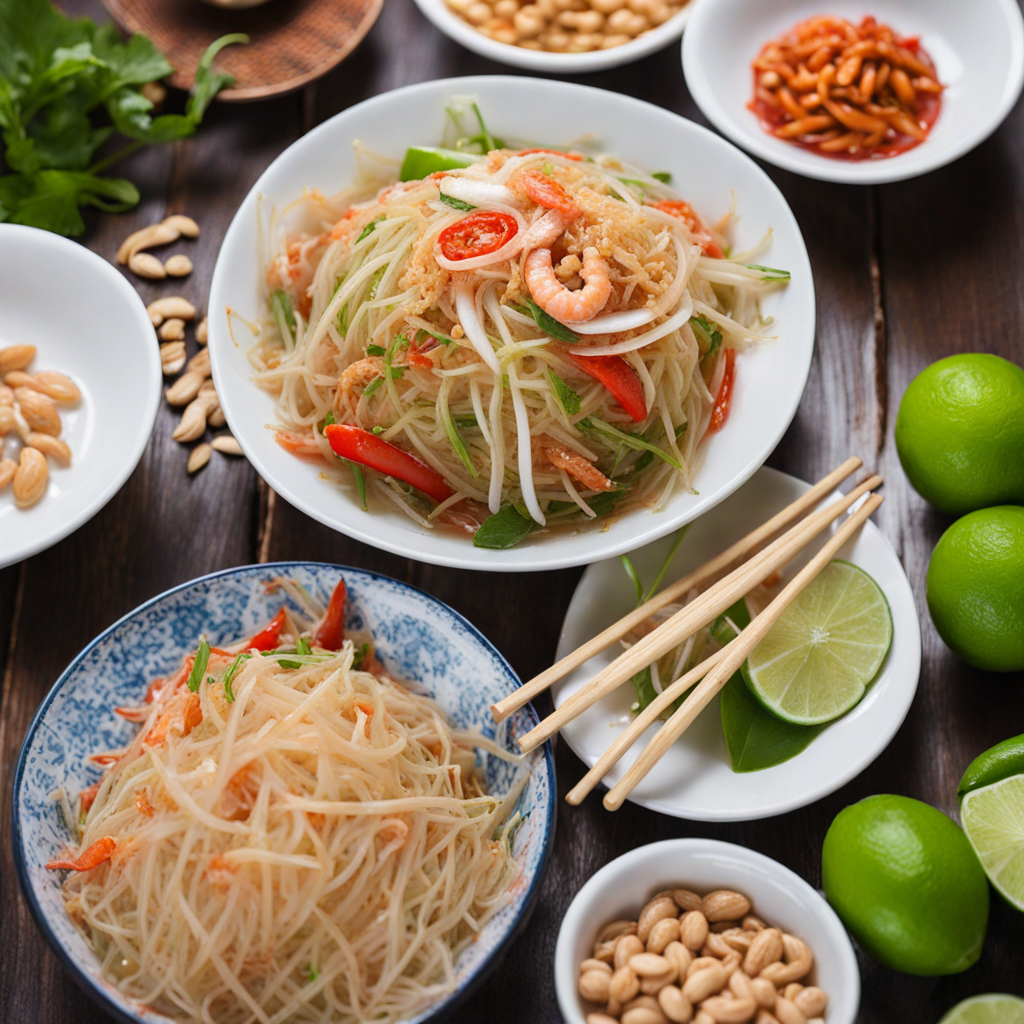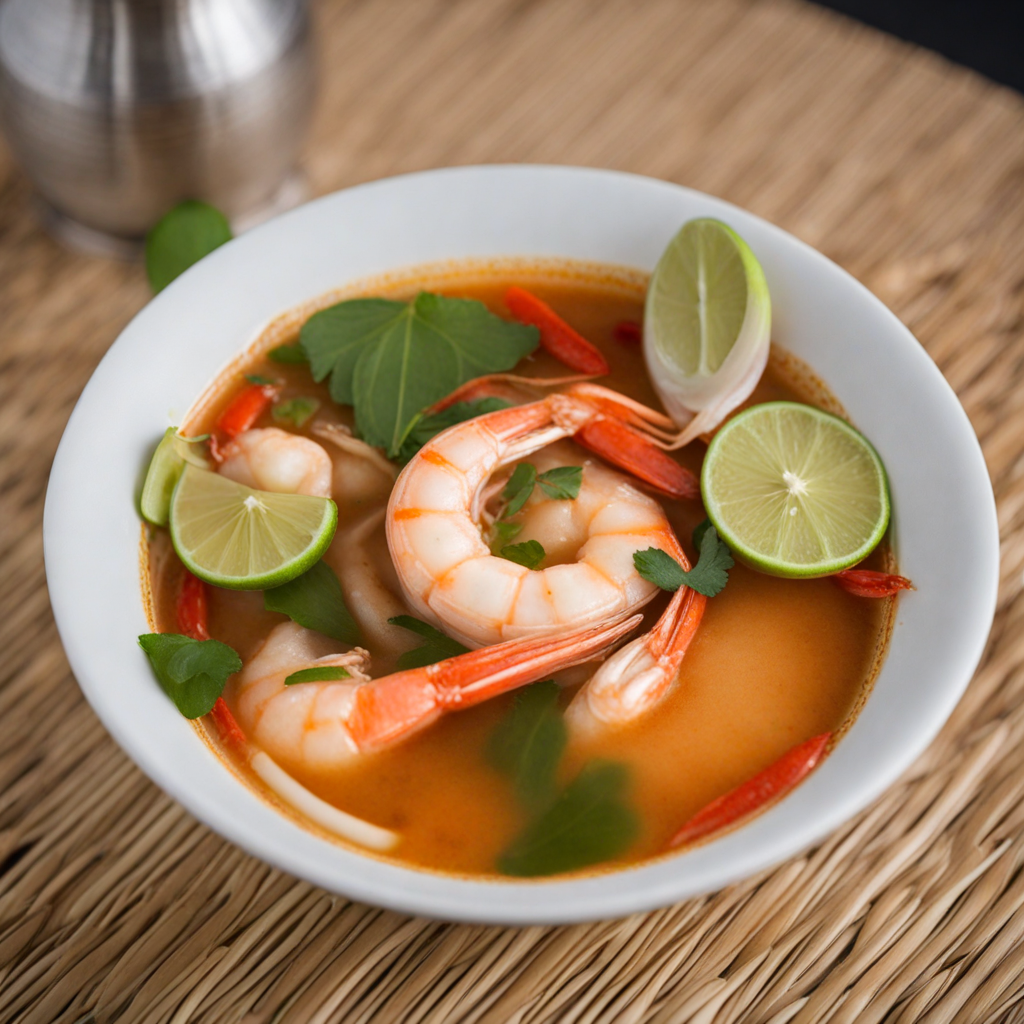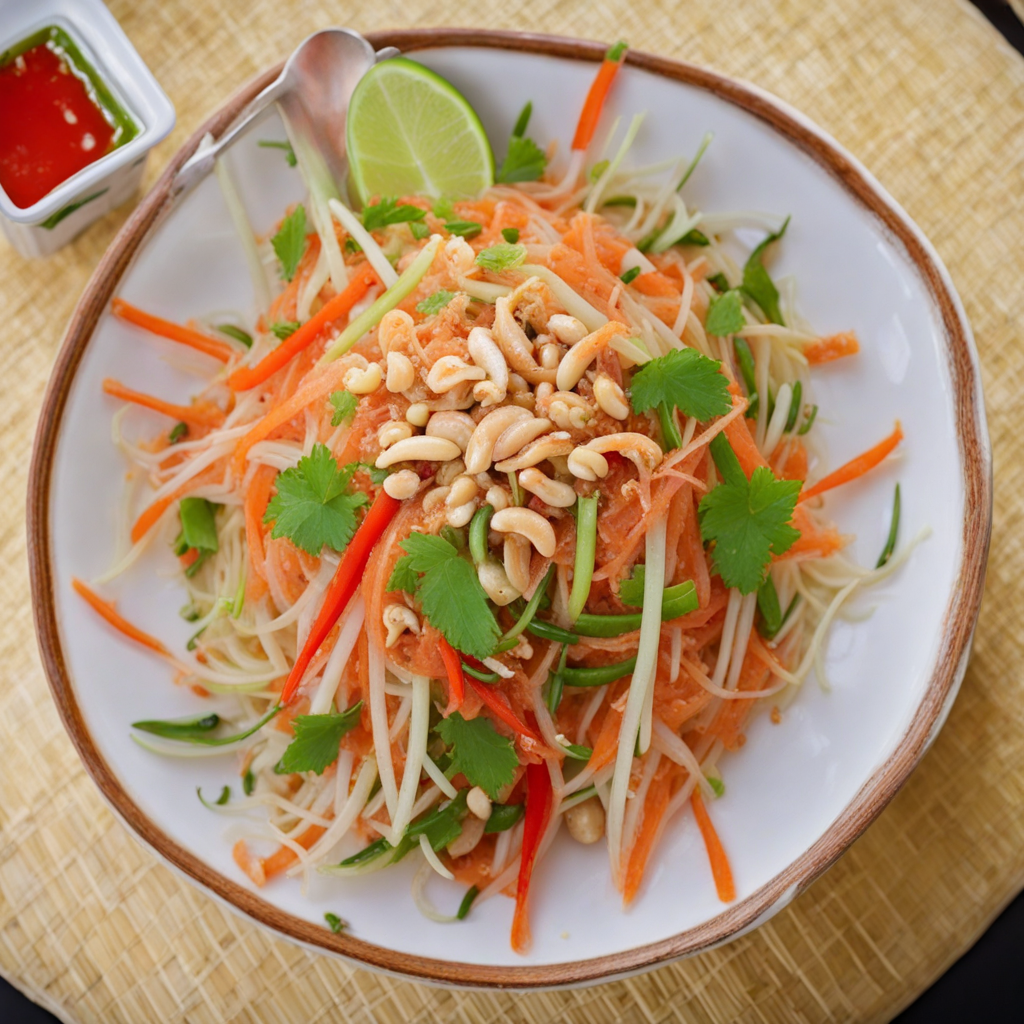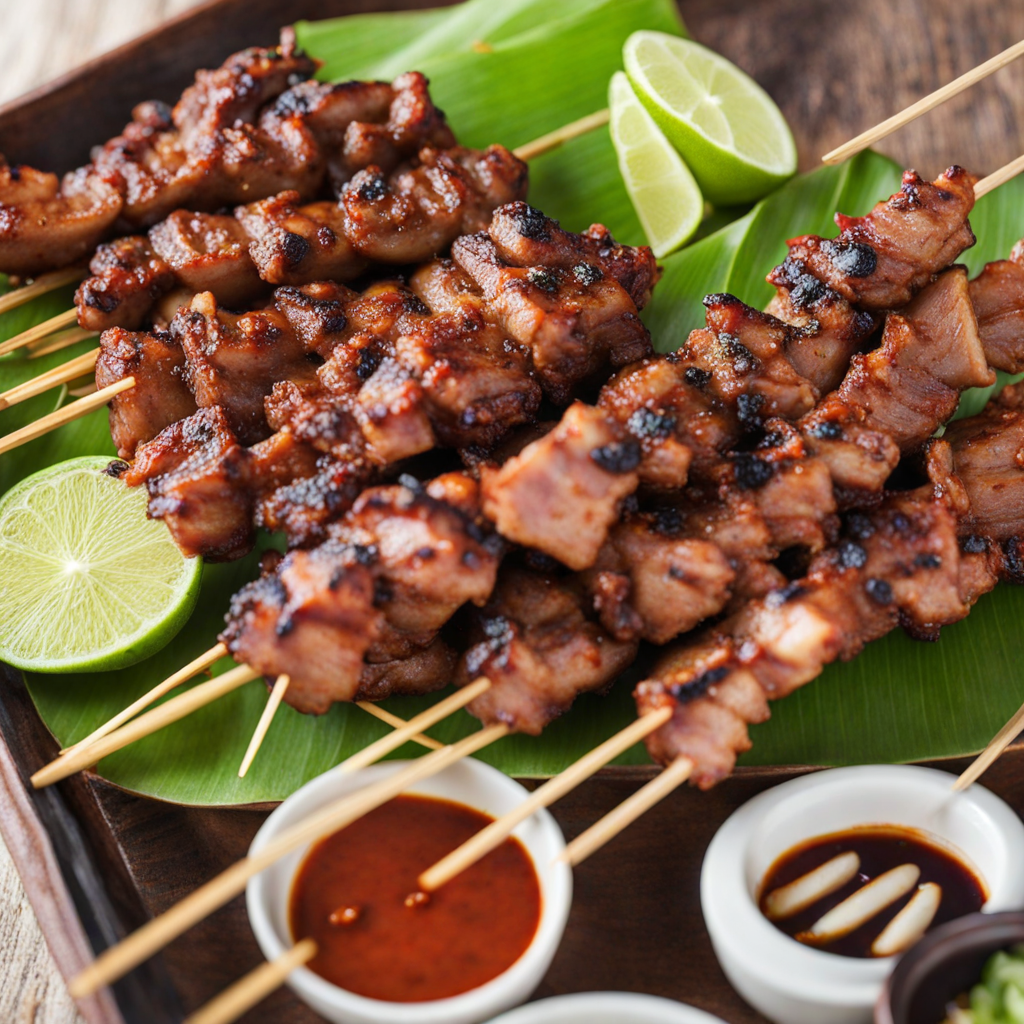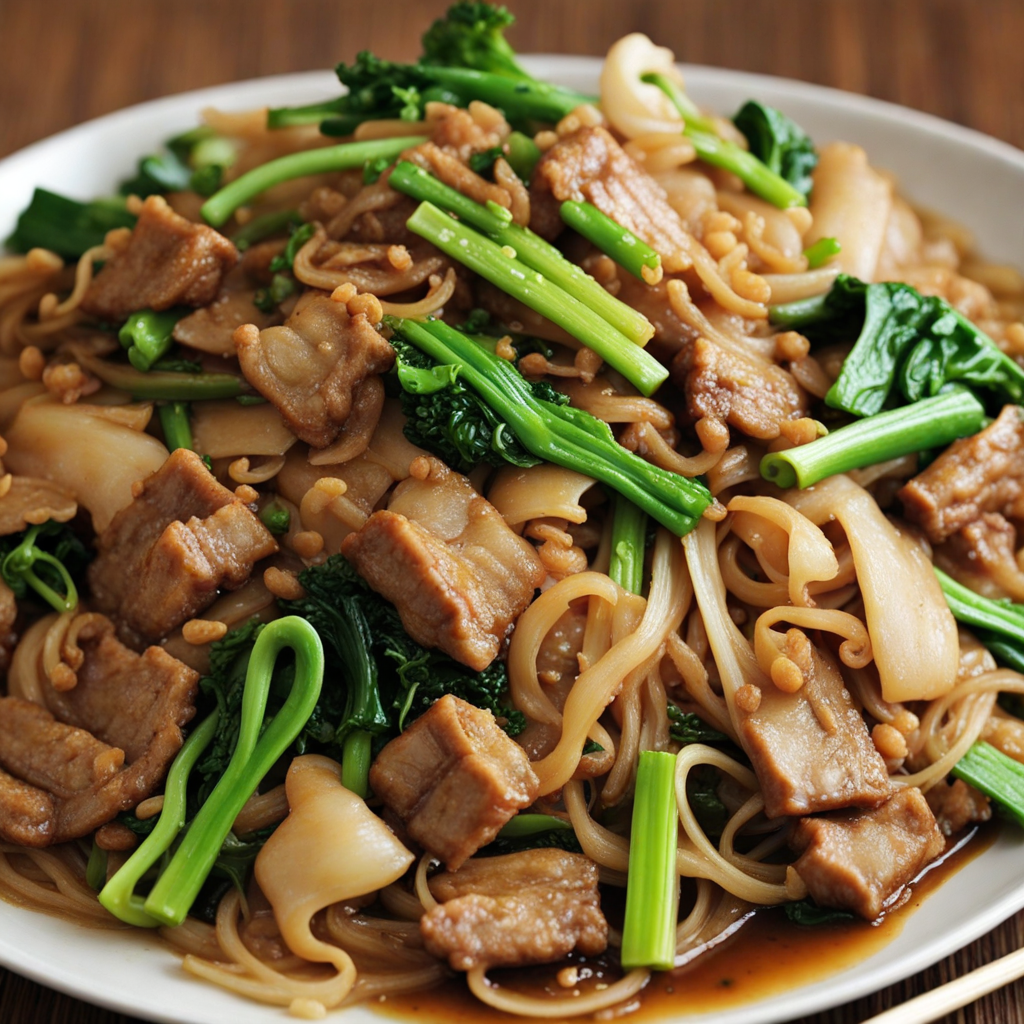Som Tum
Som Tum, a vibrant and zesty Thai salad, is a delightful explosion of flavors that will awaken your taste buds. At its core, this dish features green papaya, which is shredded into fine strips, providing a crisp texture that contrasts beautifully with the other ingredients. The salad is typically mixed with a medley of fresh herbs, tomatoes, and peanuts, contributing a refreshing element that balances the dish's vibrant flavors. Each bite offers a combination of sweetness, sourness, and saltiness, creating a harmonious blend that is both invigorating and satisfying. What truly sets Som Tum apart is its bold dressing, made from a concoction of lime juice, fish sauce, palm sugar, and chili. This dressing infuses the salad with a tangy and slightly spicy kick, making it an irresistible choice for those who enjoy a little heat. The freshness of the lime juice and the umami from the fish sauce elevate the dish, making it a perfect accompaniment to grilled meats or enjoyed on its own as a light meal. The addition of roasted peanuts adds a crunchy texture that complements the tender papaya, enhancing the overall experience. Som Tum is not just a dish; it’s a celebration of Thailand's culinary heritage. Often found at street food stalls, it embodies the essence of Thai cuisine, which emphasizes fresh ingredients and bold flavors. The versatility of Som Tum allows for variations, such as adding shrimp or salted crab, making it adaptable to different tastes. Whether you are a seasoned traveler or a food enthusiast seeking new experiences, Som Tum promises to take your palate on a delicious journey through the lively and aromatic world of Thai flavors.
How It Became This Dish
The History of Som Tum: Thailand's Beloved Papaya Salad #### Origins Som Tum, or Som Tam, is a vibrant and flavorful Thai salad that has transcended regional boundaries to become one of the most beloved dishes in Thailand and among international food enthusiasts. The dish's roots can be traced back to the northeastern region of Thailand, known as Isaan, where it is believed to have originated among the local Lao-speaking communities. The fundamental ingredient, green papaya, is native to Central America but was introduced to Southeast Asia centuries ago. This introduction marked the beginning of an exciting culinary evolution. The name "Som Tum" arises from the combination of two Thai words: "Som," meaning sour, and "Tum," meaning to pound or crush. This reflects the traditional preparation method, which involves pounding ingredients together using a mortar and pestle. The dish's sourness primarily comes from the use of lime juice, which is a hallmark of Thai cuisine. Alongside lime, other essential components include fish sauce, palm sugar, and a medley of fresh vegetables and herbs that culminate in a dish that is not only refreshing but also complex in flavor. #### Cultural Significance Som Tum holds a special place in Thai culture, serving as a symbol of the Isaan way of life and its culinary traditions. It embodies the balance of flavors, a principle deeply rooted in Thai cooking. The dish is often served as part of a larger meal, complementing sticky rice and grilled meats, making it a staple in family gatherings and communal dining experiences. It is also a popular street food, reflecting the vibrant food culture of Thailand, where street vendors skillfully prepare Som Tum right before your eyes. The dish is more than just food; it is a representation of local identity and pride. In Isaan, Som Tum is often associated with communal gatherings and celebrations, where families and friends come together to enjoy a shared meal. The variations of the dish across different regions highlight local ingredients and customs, showcasing the creativity and adaptability of Thai cuisine. #### Development Over Time Over the years, Som Tum has evolved, both in its ingredients and preparation methods. Traditionally, the basic recipe involved only green papaya, lime juice, fish sauce, palm sugar, and a few other vegetables like tomatoes and green beans. However, as Thailand became more globally connected, the dish began to incorporate a wider array of ingredients. For instance, variations may include peanuts, dried shrimp, and even fermented fish sauce, adding layers of flavor and texture. In the 20th century, with the rise of Thailand's culinary reputation on the world stage, Som Tum gained popularity beyond its regional roots. Thai restaurants around the world began offering their interpretations of the dish, often adjusting the heat level and adding creative twists to cater to local palates. This globalization of Som Tum has led to a fascinating interplay of traditional and modern culinary practices. In Thailand, there are numerous regional variations of Som Tum, each reflecting the unique taste preferences and agricultural products of different areas. For example, Som Tum Thai, which is popular in central Thailand, often includes roasted peanuts and dried shrimp, while Som Tum Lao, favored in Laos and the northeastern parts of Thailand, is typically spicier and may incorporate fermented fish sauce for an additional punch. These regional distinctions are a testament to the dish's adaptability and the rich agricultural diversity of the region. #### Modern Interpretations As Thai cuisine continues to gain international acclaim, chefs and home cooks alike have begun to explore creative interpretations of Som Tum. In urban centers like Bangkok, innovative versions of the dish might incorporate ingredients such as mango, cucumber, or even fruit like watermelon, offering a refreshing twist on the classic recipe. This evolution reflects a broader trend in culinary arts where traditional dishes are deconstructed and reimagined to appeal to contemporary tastes. Moreover, the health benefits associated with Som Tum have contributed to its popularity in recent years. With a focus on fresh ingredients, the salad is not only low in calories but also rich in vitamins and minerals, making it an attractive option for health-conscious diners. The dish's vibrant colors and fresh flavors have also made it a favorite among food bloggers and social media influencers, further enhancing its visibility and appeal. #### Conclusion Som Tum is more than just a dish; it is a reflection of the rich cultural tapestry of Thailand. From its humble origins in Isaan to its status as a global culinary phenomenon, Som Tum captures the essence of Thai food: a harmonious blend of flavors, textures, and colors that delights the senses. It stands as a testament to the adaptability of traditional culinary practices in the face of globalization while remaining deeply rooted in its cultural heritage. As food lovers around the world continue to discover and embrace Som Tum, the dish serves as a delicious reminder of the importance of community, tradition, and the joy of sharing a meal. Whether enjoyed as a street food snack or a centerpiece at a festive gathering, Som Tum will undoubtedly continue to evolve and inspire future generations of cooks and food enthusiasts alike. The story of Som Tum is, in many ways, a story of Thailand itself—a celebration of flavor, culture, and the enduring power of food to bring people together.
You may like
Discover local flavors from Thailand


